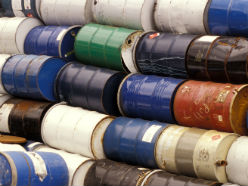
Analysts have a bullish outlook for Canadian crude over the next decade as new pipelines come online and oil prices slowly edge up.
The Justin Trudeau government has less than a month to issue a decision on Kinder Morgan’s proposal to expand its Trans Mountain pipeline from Alberta to the Pacific Coast, which would open an export terminal to Asia and nudge up Canadian crude prices on higher demand.
The controversial Trans Mountain expansion is facing regional and environmental opposition—with Vancouver Mayor Gregor Robertson saying it will draw “protests like you’ve never seen before”—but analysts see it going through. Skip York, vice-president of integrated energy for Americas research at Wood Mackenzie, sees the expansion operating by 2019 or 2020.
Read: Trump policy cheat sheet
The expanded Trans Mountain pipeline could ship 750,000 barrels per day, he says, and another million barrels per day could come online from the proposed Energy East link to the Atlantic Coast sometime between 2025 and 2030.
“If we get oil back to US$80 per barrel, and access to global markets through the Trans Mountain expansion, the combination of those two really creates a healthy environment for Canadian oil sands,” York says.
A barrel of Western Canadian Select, an index for Canadian crude, trades at a discount from a barrel of the U.S. benchmark, West Texas Intermediate. (The discount has been about US$15 in recent months.) That’s partly because almost all Canadian oil exports go to the U.S.
Proponents of the Trans Mountain expansion say it would provide a “netback price” premium of US$2 to US$4 per barrel as Canada’s export market is diversified. That would come as crude oil prices globally are expected to slowly pick up over the next 10 years.
Read: What may hold back ‘Trumpflation’
“You can put all the Teslas you want on the streets of Toronto. That’s not going to make a difference to the oil demand,” says Tim Pickering, founder and lead portfolio manager for Auspice Capital in Calgary, which offers a Canadian crude oil ETF that tracks prices.
He says emerging markets will help with rising oil demand. “Forget peak oil, it’s peak demand. When’s peak demand? It’s a long way off,” Pickering says.
Even as energy efficiencies slow demand in developed economies, York expects oil to settle at about US$80 per barrel between 2020 and 2025, adjusted for inflation. (In nominal prices, a barrel may cost above US$100.)
McKinsey & Company said earlier this year that European and North American energy demand will decline through 2050 as emerging and developing countries drive demand. The firm predicts total oil demand growth to nearly flatten to 0.4% in 2025.
By 2030, electric vehicles, including hybrids and battery-powered plug-in vehicles, may be close to 50% of new cars sold in China, the EU and the U.S., or about 30% of new cars globally, McKinsey says. Ark Invest, an investing firm, forecasts that oil demand will peak by 2025. It forecasts demand to then decline to 90 million barrels per day by 2035.
Read: How geopolitics is affecting emerging markets
Pickering says the Keystone XL pipeline project—which could get back on track after Donald Trump enters the White House—matters less now as Alberta has more oil storage and existing pipeline capacity to the U.S. has been optimized.
The Keystone XL pipeline is not a “game changer,” he says.